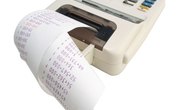
The IRS receives millions of tax returns every year from individuals and businesses, filed electronically and through the mail. As a result, the agency has developed an efficient system for processing these returns through the use of computers and highly trained staff. If you file a tax return, someone will lay eyes on it; however, the depth of the review will not always be the same. The tax return review process has multiple steps, and not every return will be scrutinized carefully.
Tips
The IRS does check each and every tax return that is filed. If there are any discrepancies, you will be notified through the mail.
The IRS Review Process: Every Return Is Reviewed by Computer
When you mail your completed tax returns to the IRS, a machine does the initial sorting, opening envelopes and setting aside returns that include payments by check. The returns move on to employees, who sort the returns based upon their type. The returns are batched into groups, and the information they contain is entered into an electronic system by other IRS employees called data transcribers. Once the data is in the system, a computer checks the return for errors, such as mathematical errors; if none are found, the return is processed, and the IRS issues you either a refund or a balance due notice.
If errors are found, the return will be reviewed by a Tax Examiner, who makes any corrections and may contact you for more information if necessary. Once the corrections are made, the return will be processed.
For returns filed electronically, the process is far more streamlined, but the result is the same: your return will be reviewed by computers and live employees.
Audit Selection: Thorough IRS Review of Tax Returns
Occasionally, the IRS will conduct an audit of a certain tax return. A return may be flagged for an audit for a number of reasons, including:
- Random Selection. The IRS selects random returns and reviews them based upon a statistical sample, comparing the randomly selected return against similar returns and flagging it for audit if discrepancies are found.
- Indicators of Fraud. A return may be flagged for audit if the Tax Examiner determines that the return contains indicators of fraud. The IRS has compiled a long list of things that may trigger a fraud audit, including failure to report substantial amounts of income, inability to explain substantial increases in net worth, overstating or inventing deductions, or using a false Social Security number. These "badges of fraud" are just a small sample of what may cause a fraud flag on a return.
- Related Examinations. A business owner whose business partner or business is audited may also be subjected to an audit as part of the comprehensive review.
Once a return is flagged for review, an auditor will review the return and decide whether to accept the return or forward it on for further examination.
Many audits are conducted by mail. If the IRS finds a discrepancy that is easily rectified by documentation, it will contact the taxpayer by mail and request documents. If the taxpayer forwards the documents and they are satisfactory, the audit will be complete and the return will be accepted. If the documents show an error, corrections may be made, or the taxpayer may need to file an amended return.
For more complicated issues, the IRS may schedule an in-person interview either at the taxpayer's home or at a local IRS office. If the taxpayer is a business, it may be conducted at the business' main location.
Once the audit is complete, the taxpayer will be assessed any taxes owed or will be issued a refund if one is due.
Read More: Where's My Tax Refund: An Easy Guide
References
Writer Bio
Rebecca K. McDowell is an attorney focused on debts and finance. She has a B.A. in English and a J.D. She has written finance and tax articles for Zacks and eHow.

